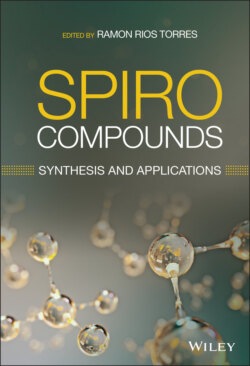Spiro Compounds

Реклама. ООО «ЛитРес», ИНН: 7719571260.
Оглавление
Группа авторов. Spiro Compounds
Table of Contents
List of Tables
List of Illustrations
Guide
Pages
Spiro Compounds. Synthesis and Applications
List of Contributors
Preface
1 Spiro Compounds: A Brief History
1.1 Notes on IUPAC Rules for Spiro Compounds
References
2 Selected Applications of Spirocycles in Medicinal Chemistry
2.1 Introduction
2.2 General Features
2.3 Property Optimization in Bioactive Compounds
2.4 Four‐Membered Rings: Synthesis, Applications, and New Design Principles
2.5 Further Examples
2.6 Conclusions
References
3 Recent Advances in the Asymmetric Synthesis of Spiro Compounds Through Cycloadditions
3.1 Introduction
3.2 Organometallic Methodologies
3.2.1 Organometallic [3+2] Cycloaddition Strategies to Construct Spiro Compounds
3.2.2 Organometallic [4+2] Cycloaddition Strategies to Construct Spiro Compounds
3.2.3 Organometallic Miscellaneous Strategies to Construct Spiro Compounds
3.3 Organocatalytic Methodologies
3.3.1 Organocatalytic [3+2] Cycloaddition Strategies to Construct Spiro Compounds
3.3.2 Organocatalytic [4+2] Cycloaddition Strategies to Construct Spiro Compounds
3.3.3 Organocatalytic [4+3] and [2+2] Cycloaddition and Switchable Strategies to Construct Spirocompounds
3.3.4 Organocatalytic Miscellaneous Strategies to Construct Spiro Compounds
References
4 Design and Synthesis of Spirocycles via Olefin Metathesis
4.1 Introduction
4.2 Formation of Aza‐spirocycles
4.3 Formation of Oxa‐spirocycles
4.4 Miscellaneous Examples
References
5 Spirooxindoles: Synthesis via Organocatalytic Processes
5.1 Introduction
5.2 Enamine and Iminium Catalysis
5.3 Chiral Nucleophilic Catalysis with Tertiary Phosphines or Amines
5.4 Chiral N‐Heterocyclic Carbene Catalysis
5.5 Chiral Tertiary Amine‐H‐Bond Donor Bifunctional Catalysis
5.6 Chiral Hydrogen‐Bonding Catalysis
5.7 Chiral Phosphoric Acid Catalysis
5.8 Chiral Phase‐Transfer Catalysis
5.9 Chiral Organoiodine Catalysis
5.10 Conclusion
References
6 Spirooxindole Synthesis by Organometallic Processes
6.1 Introduction
6.2 Direct Construction of the Spirooxindole Unit by Cyclization Methodologies. 6.2.1 Intramolecular Heck Reaction and Related Cyclizations
6.2.2 Alkylation–Cyclization of 3‐Substituted Oxindoles
6.2.3 Cyclization of 3‐Substituted Indoles
6.3 Two‐component Annulation/Cycloaddition Methodologies. 6.3.1 Cyclopropyl Spirooxindoles by [2+1] Cycloaddition Reactions
6.3.2 [2+2] Cycloaddition Reactions
6.3.3 [3+2] Annulation/Cycloaddition Reactions
6.3.4 [3+3] Cycloaddition Reactions
6.3.5 [4+1] Cycloaddition Reactions
6.3.6 [4+2] Cycloaddition/Annulation Reactions
6.3.7 [5+2] Cycloaddition Reactions
6.4 Miscellaneous Methods. 6.4.1 Darzens Reaction of Isatins
6.4.2 Cyclization of 3,3‐Disubstituted Oxindoles
6.4.3 Three‐component Reactions
6.5 Conclusions
Acknowledgements
References
7 Enantioselective Synthesis of Spiro Heterocycles
7.1 Introduction
7.2 Enantioselective Synthesis of Spiro Heterocycle with One Nitrogen Atom. 7.2.1 Enantioselective Formation of Spiropyrrolidines. 7.2.1.1 Organometallic Approaches
7.2.1.2 Organocatalytic Approaches
7.2.1.3 Cooperative‐catalytic Approaches
7.2.2 Enantioselective Formation of Spirocycles Containing Indoline and Indolenine Ring. 7.2.2.1 Organometallic Approaches
7.2.2.2 Organocatalytic Approaches
7.2.3 Enantioselective Formation of Spiropiperidines. 7.2.3.1 Organometallic Approaches
7.2.3.2 Organocatalytic Approaches
7.3 Enantioselective Formation of Spirocycles Containing Heterocycle with One Oxygen Atom. 7.3.1 Enantioselective Formation of Spirocycles Containing Dihydrofuranone and Tetrahydrofuran Ring. 7.3.1.1 Organometallic Approaches
7.3.1.2 Organocatalytic Approaches
7.3.2 Enantioselective Formation of Spirocycles Containing Benzofuranone and Benzodihydrofuran Ring. 7.3.2.1 Organometallic Approaches
7.3.2.2 Organocatalytic Approaches
7.3.2.3 Cooperative‐catalytic Approaches
7.3.3 Enantioselective Formation of Spirocycles Containing Dihydrocoumarin, Dihydro‐ and Tetrahydropyran Ring. 7.3.3.1 Organometallic Approaches
7.3.3.2 Organocatalytic Approaches
7.4 Enantioselective Formation of Sulfur‐containing Spirocycles
7.5 Enantioselective Formation of Spirocycles Containing Heterocycle with More Than One Heteroatom. 7.5.1 Enantioselective Formation of Spirocycles Containing Pyrazolone Ring. 7.5.1.1 Organometallic Approaches
7.5.1.2 Organocatalytic Approaches
7.5.1.3 Cooperative‐catalytic Approaches
7.5.2 Chapter 7.5.2 – Enantioselective Formation of Spirocycles Containing Barbituric Acid and Hydantoin
7.5.3 Chapter 7.5.3 – Enantioselective Formation of Spirocycles Containing Azlactones. 7.5.3.1 Organometallic Approaches
7.5.3.2 Organocatalytic Approaches
7.5.3.3 Cooperative‐catalytic Approaches
7.5.4 Chapter 7.5.4 – Enantioselective Formation of Spirocycles Containing Rhodanines and Sultams
7.5.4.1 Organometallic Approaches
7.5.4.2 Organocatalytic Approaches
7.5.5 Chapter 7.5.5 – Enantioselective Formation of Spiroketals (Spiroacetals)
7.5.5.1 Organometallic Approaches
7.5.5.2 Organocatalytic Approaches
7.5.5.3 Cooperative‐catalytic Approaches
7.6 Enantioselective Formation of Other Spiro Heterocyclic Systems
7.6.1 Organometallic Approaches
7.6.1.1 Organocatalytic Approaches
7.7 Enantioselective Formation of Bispirocycles
7.8 Conclusion
Acknowledgements
References
8 Enantioselective Synthesis of all Carbon Spiro Compounds
8.1 Enantioselective Synthesis of All‐Carbon Spiro Compounds Based on Alkylation Methods
8.2 Enantioselective Synthesis of All‐Carbon Spirocycles by Metal‐catalyzed Methods
8.3 Enantioselective Synthesis of All‐Carbon Spirocycles by Cycloaddition Strategies
8.4 Enantioselective Synthesis of All‐Carbon Spirocycles by Radical Strategies
8.5 Enantioselective Synthesis of All‐Carbon Spirocycles by Cascade Reactions
8.6 Enantioselective Synthesis of All‐Carbon Spirocycles by Rearrangement Strategies
8.7 Conclusions
References
9 Transition‐Metal‐Catalyzed Dearomative Spiroannulation Reactions
9.1 Introduction: Discovery of Aromatic Compounds
9.2 Development of Dearomatization Reactions
9.3 Development of Dearomative Spiroannulation Reactions
9.4 Dearomative Spiroannulations of Phenols
9.4.1 Dearomative Spiroannulation Without Oxidants. 9.4.1.1 Dearomative Alkylation of Phenols
9.4.1.2 Dearomative Arylation of Phenols
9.4.2 C–H Bond Activation/Dearomative Spiroannulation Reactions
9.5 Dearomative Spiroannulation of Indoles
9.5.1 Intramolecular Dearomative Allylic Alkylation
9.5.2 Intramolecular Dearomative Arylation
9.5.3 Intermolecular Dearomative Spiroannulation of Indoles
9.6 Dearomative Spiroannulation of Aromatic Heterocyclic Compounds. 9.6.1 Dearomative Spiroannulation of Pyrroles
9.6.2 Dearomative Spiroannulation of Furans
9.6.3 Dearomative Spiroannulation of Thiophenes
9.7 Dearomative of Other Aromatic Compounds
9.8 Conclusion
References
10 Carbocyclic Spiro Compounds Occupying Higher Dimensions: Benzoannelated [5.5.5.5]Fenestranes and Beyond
10.1 Introduction
10.2 Selected Synthesis Strategies
10.2.1 The Access to Benzoannelated Fenestranes
10.2.2 Derivatives of [5.5.5.6]‐Fenestranones and Fenestrindane
10.2.3 Fenestrindanes as a Core Embedded in a Closed π‐Electron Periphery
10.2.4 Three Spiranes Merged in a Centropolycyclic Framework: Centrohexaindane and Its Derivatives
10.3 Conclusions
Acknowledgements
References
11 The Synthesis of Natural Products Containing Spirocycles
11.1 Porco’s Synthesis of (+)‐Calafianin [2]
11.2 Hayashi’s Total Synthesis of Pseurotin A[6]
11.3 Trost’s Synthesis of (−)‐Ushikulide A [12]
11.4 Castle’s and Herzon’s Syntheses of (−)Acutumine
11.4.1 Castle’s Synthesis of (−)‐acutamine [23]
11.4.2 Herzon’s Synthesis of (−)‐Acutumine [24]
11.5 Overman’s and Carreira’s Synthesis of Spirotryprostatin B
11.5.1 Overman’s Synthesis of Spirotryprostatin B [33]
11.5.2 Carreira’s Synthesis of (−)‐Spirotryprostatin B [31]
11.6 Conclusion
References
Index. a
b
c
d
e
f
g
h
i
k
l
m
n
o
p
r
s
t
u
v
w
x
z
WILEY END USER LICENSE AGREEMENT
Отрывок из книги
Edited by
.....
Scheme 3.12 Rhodium‐catalyzed [2+2+2] cycloadditions between alkynes and cyclopropylideneacetamides.
Source: Based on Yoshida et al. [23].
.....